Matthew Rampley
Architecture in the Provinces: Method, Judgement and the Topographical Impulse
This article is a historiographical reflection on a tradition within Czech art and architectural history. Specifically, it is an analysis of the tradition of local architectural history. It argues that this tradition is without parallel in international scholarship, in terms of the volume of publications written by trained scholars about the architectural of regional towns, cities and regions. On the one hand, it argues that this is a highly welcome phenomenon, since it contradicts the focus on the metropolis that so often dominates scholarship on the history of architecture. At the same time, however, it argues that this large literature suffers a systemic weakness, in that little goes beyond topographic documentation of buildings and sites. This ‘topographic impulse,’ as the article terms it, is a product of nineteenth-century positivism, and suffers the same shortcomings, namely, the lack of a critical conceptual apparatus that can enable it to make judgements about architectural significance. The culmination of this can be seen in the production of vast scholarly works of architectural history that may seem out of proportion to the significance of their subject. Or, to put it in a different, vast scholarly works in which the significance of the subject is never spelled out. The article thus concludes by emphasising the hermeneutic inter-dependence of the individual building / structure and wider historical, social, cultural or political frameworks.
Author's email:
rampley@udu.cas.cz
DOI: HTTPS://DOI.ORG/10.54759/ART-2022-0106
Full-text in the Digital Library of the Czech Academy of Sciences:
https://kramerius.lib.cas.cz/uuid/uuid:bc94a067-71c0-482b-af8c-23dc005242e9
< back

